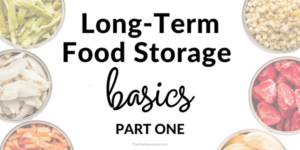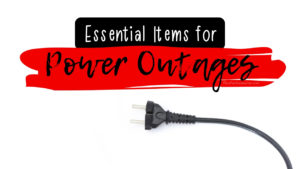
Long Term Food Storage Basics: What you need to Know to Get Started
Answers to some of your most asked questions about long-term food storage, including the difference between dehydrated and freeze dried food.

First things first, let’s address the million dollar question:
Is it worth the sacrifice?
Absolutely!
#1 – Even if you are never faced with a serious situation like a food shortage, job loss, etc both short and long-term food storage provide 2 priceless things:
I cannot tell you how many times I have thanked my past self for getting multiples of items, so that when I run out in the middle of cooking dinner, I don’t have to run to the store.
I also cannot tell you how many times having a can of sour cream powder, instant milk, eggs, or other staples, has saved me in a pinch when I realized we were out of them in normal form.
#2 – If you are faced with food storages, job loss, etc, the benefits are pretty self explanatory.
Either way, I say without reservation, the sacrifice is 100% worth it!
If you’re looking for information on long-term food storage, you can find that in this series of blog posts.
But, before I get into the basics of short-term food storage, I thought it would be helpful to distinguish the difference between short-term and long-term food storage.
The next time you go to the grocery store, add a couple extras of everything you are getting that won’t expire too soon (budget and space allowing).
Don’t get hung up on having a perfectly calculated spreadsheet of how many of each item you want to eventually have. You’ll spend WAY too long trying to figure that out, when you could have been accumulating food all that time.
Pay attention to expiration dates. Don’t get 50 cans of something that you only use twice a year.
You’re gonna end up throwing away a lot of food if you’re not paying attention to your general consumption timeframe vs expiration dates.
If you find yourself at Target with a mostly empty cart, snag a big pack of toilet paper.
If you’re at the grocery store and have lots of room in your cart, pick up some things that you wouldn’t normally have room for extras of (boxes of pasta, bags of rice, canned goods).
Add extras of sale items to your cart.
Of course, don’t do this if you already have a ton of that sale item. But if you know you don’t have many extras of something that is on sale, and something that isn’t on sale, go with the sale item that day.
Rather than getting a year’s worth of one item before moving on to the next, try to spread the love.
Start out with getting enough of everything for two weeks and build from there (don’t forget all 3 meals, plus snacks).
Then try to double that, so you have a month’s worth of all the things.
Then go for 2 months, etc.
Whatever you have is going to be better than nothing. Don’t stress about having the perfect amount of every single thing you use (ESPECIALLY at the beginning).
As time goes on, you can be more intentional.
Well? What do you think? Are you ready to grab a few extras the next time you go to the grocery store?
Remember tip #1 – JUST START!

Answers to some of your most asked questions about long-term food storage, including the difference between dehydrated and freeze dried food.

While every family’s food storage needs are a little different, every family needs food storage. These 12 items are my top favorites – most of them I even use on a regular basis when I’m out of the grocery store version.

If you live in California, you are probably wondering where to start to get prepared for the planned public safety power outages this fire season.
